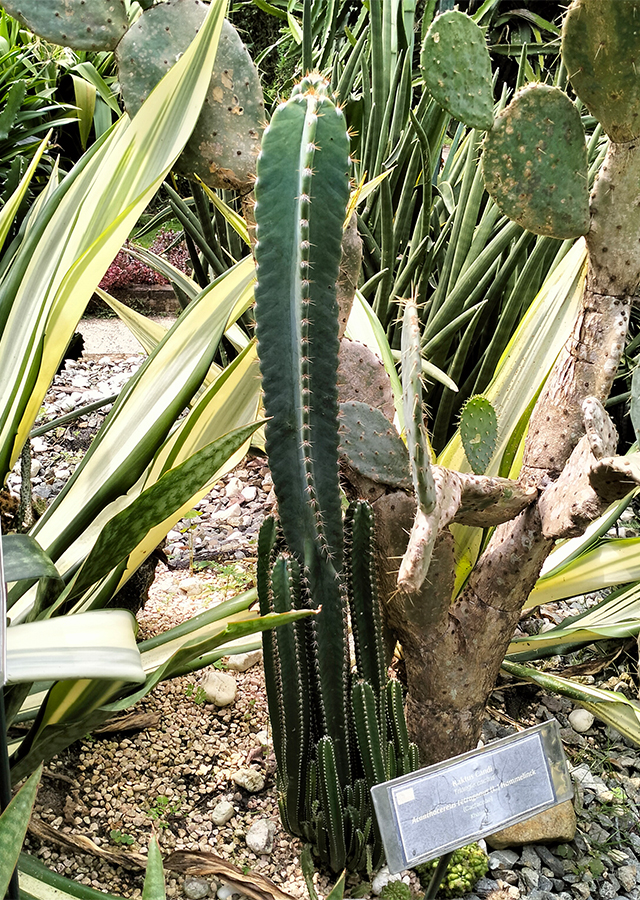Fairy Castle Cactus
Acanthocereus tetragonus (L.) Hummelinck
Cactaceae
Location in our garden
Orchard



Synonym
Cactus tetragonus L.
Cereus dussii K.Schum.
Cereus tetragonus (L.) Mill.
Habitus
Succulent. Succulent, grows to 2-7 m
Part Used
Stem
Growing Requirements
Full Sunshine
Habitat
Coastal
Overview
Acanthocereus tetragonus, also known as the fairy castle cactus, is an arid tropical and subtropical plant. Its natural distribution includes the coastal areas of South Texas, Florida, the West Indies, Mexico, Central America and northern South America and has been cultivated worldwide. This cactus, endemic to Mexico and Central America. This plant produces edible fruit, and is used as an alternative food source in some Mexican communities. The fairy castle cactus is also used to create living hedges, especially in the lowlands of the Pacific coast. Apart from that, traditionally the cactus has also been used by the community as a medicinal plant, which is believed to be able to overcome various ailments.
Vernacular Names
No data found on this. Need further research.
Agroecology
Acanthocereus tetragonus can generally be found growing in sandy, low-lying coastal areas. This plant can grow in light (sandy) and medium (loam), well-drained soil in a sunny position, also able to grow in nutrient-poor soil. A. tetragonus likes dry soil conditions and can tolerate drought, as well as soils with an acidity level (pH) in the range of 6 - 7.5.
Morphology
- Roots - fibrous.
- Stems - dark green, columnar, forked and branches gather vertically to form "fairy castle" towers, curved, sharply angled ribs, usually 3 on mature culms, 4-5 on juvenile culms, short white spines growing along the spine lateral. The areoles are gray, the central areola has one to two spines up to 4 cm long, while the radial areola has six to eight spines up to 2.5 cm long.
- Flowers - bisexual, the inner tepals are pure white, the outer tepals are greenish-white, the stamens are yellow, the pistils are creamy white, slightly fragrant.
- Fruits - red, watery, oval in shape, about 2.5 cm in diameter, the surface of the fruit is glossy, the taste is sweet.
Cultivation
- Plant propagation through seeds and stem cuttings.
- Propagation by seed - removing the seeds from the pulp and drying them thoroughly before sowing.
Chemical Constituents
Carboxylic acids such as threonic, citric and malic acids, eucomic acid, sinapic acid, glycosylated flavonoids (luteolin-O-rutinoside).
Traditional Medicinal Uses
- Minimizes internal bleeding.
- Acts as a diuretic.
Part Used
Reference Sources
- Plants For A Future. 2022. Acanthocereus tetragonus - (L.) Hummelinck. https://pfaf.org/user/Plant.aspx?LatinName=Acanthocereus+tetragonus. 06-01-23.
- Cornejo-Campos J. et al. 2022. Impact of the Cooking Process on Metabolite Profiling of Acanthocereus tetragonus, a Plant Traditionally Consumed in Mexico. Molecules, 27(12), 3707; https://doi.org/10.3390/molecules27123707.
- La Palomera. 2020. Ethnobotanical Dictionary, Barbed wire cactus: Acanthocereus tetragonus (L.) Hummelinck. https://en.lapalomera.org/especies/004-plant-003-nopal-de-cruz. 06-01-23.
- Lady Bird Johnson, Wildflower Center. Acanthocereus tetragonus. https://www.wildflower.org/plants/result.php?id_plant=acte4. 06-01-23.
